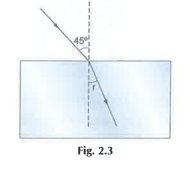Light in vacuum is incident on the surface of a glass slab. In the vacuum the beam makes an angle of a glass slab. In the vacuum the beams makes an angle of 37∘ with the normal to the surface, while in the glass it makes an angle of 23.5∘ with the normal. What is the index of refraction of the glass ?
The correct Answer is:1.56
To find the index of refraction of the glass slab, we can use Snell's Law, which states:
sinisinr=n2n1
Where:
- i is the angle of incidence (in vacuum),
- r is the angle of refraction (in glass),
- n1 is the refractive index of the first medium (vacuum, which is 1),
- n2 is the refractive index of the second medium (glass, which we want to find).
1. Identify the angles:
- Angle of incidence, i=37∘
- Angle of refraction, r=23.5∘
2. Apply Snell's Law:
sinisinr=n2n1
Since n1=1 (for vacuum), the equation simplifies to:
sini=n2⋅sinr
3. Calculate sini and sinr:
- Calculate sin37∘ and sin23.5∘:
- sin37∘≈0.6018
- sin23.5∘≈0.3987
4. Substitute the values into Snell's Law:
sin37∘sin23.5∘=n2
n2=0.60180.3987
5. Calculate n2:
n2≈1.51
Final Answer:
The index of refraction of the glass is approximately 1.51.
---
- i is the angle of incidence (in vacuum),
- r is the angle of refraction (in glass),
- n1 is the refractive index of the first medium (vacuum, which is 1),
- n2 is the refractive index of the second medium (glass, which we want to find).
- Angle of incidence, i=37∘
- Angle of refraction, r=23.5∘
sinisinr=n2n1
Since n1=1 (for vacuum), the equation simplifies to:
sini=n2⋅sinr
- Calculate sin37∘ and sin23.5∘:
- sin37∘≈0.6018
- sin23.5∘≈0.3987
sin37∘sin23.5∘=n2
n2=0.60180.3987
n2≈1.51
The index of refraction of the glass is approximately 1.51.
Topper's Solved these Questions
- GEOMETRICAL OPTICS : REFRACTIONBOOK - RESNICK AND HALLIDAYCHAPTER - GEOMETRICAL OPTICS : REFRACTIONEXERCISE - Practice questions(single correct choice type)
49 Videos
- GEOMETRICAL OPTICS : REFRACTIONBOOK - RESNICK AND HALLIDAYCHAPTER - GEOMETRICAL OPTICS : REFRACTIONEXERCISE - Practice questions(More than one correct choice type)
14 Videos
- GEOMETRICAL OPTICS : REFRACTIONBOOK - RESNICK AND HALLIDAYCHAPTER - GEOMETRICAL OPTICS : REFRACTIONEXERCISE - Check point
6 Videos
- GEOMETRICAL OPTICS : REFLECTION BOOK - RESNICK AND HALLIDAYCHAPTER - GEOMETRICAL OPTICS : REFLECTION EXERCISE - PRACTICE QUESTIONS (Integer Type)
3 Videos
- GRAVITATIONBOOK - RESNICK AND HALLIDAYCHAPTER - GRAVITATIONEXERCISE - PRACTICE QUESTIONS (INTEGER TYPE)
4 Videos
Similar Questions
A ray of light travelling in air falls on the surface of a transparent slab. The ray makes an angle of 45∘ with the normal to the surface. Find the angle made by the refracted ray with the normal within the slab. Refractive index of the material of the slab =√2.

View SolutionIf a ray of light propagating in air strikes a glass slab at an angle of 30∘ with the surface of the slab, the angle of refraction is
View Solution
Knowledge Check
White light is incident normally on a glass slab. Inside the glass slab,
Ared light travels faster than other coloursBviolet light travels faster than other coloursCyellow light travels faster than other coloursDall colours travels with the same speed.A ray of light strikes a glass slab at an angle of 50∘ with the normal to the surface of the slab. What is the angle of incidence?
A50∘B25∘C40∘D100∘A ray of light strikes a glass slab at an angle of 50∘ with the normal to the surface of the slab. What is the angle of incidence?
A50∘B25∘C40∘D100∘
A ray of light strikes the glass slab at an angle of 90∘ from its surface. What is the angle of incidence and the angle of refraction ?
View SolutionIf a ray of light propagating in air strikes a glass slab at an angle of 60∘ with the surface of the slab, the angle of refraction is …......................
View SolutionA ray of light makes an angle of 50∘ with the surface S, of the glass slab. Its angle of incidence wil be ________.
View SolutionA ray of light is incident on a glass slab of refractive index 1.5, making an angle of 40∘ with the surface. The angle of refraction in glass is
View SolutionA ray of light is incident on a glass slab at an angle of 45∘. If refractive index of glass be 1.6, what is the angle of refraction ?
View Solution
